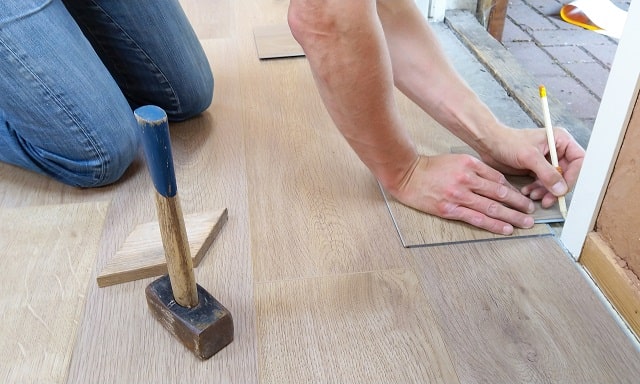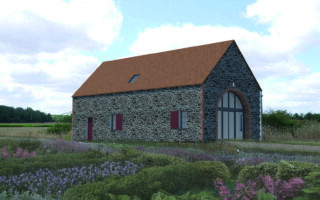Renovation projects in France


D-I-Y in the Loire
Renovating a house in France, from building methods to products used, can often be very different from renovating in the UK. However, a few things, like delays, seem to be universal to builders everywhere.
In France, DIY is a relatively new phenomenon, although it is expanding fast.
For those of us used to the extensive do-it-yourself culture in the UK and U.S., the relative lack of products here can be challenging and you should expect to drive some distance to find the big stores that stock a large range of goods.
Some to look out for are Castorama, Bricomarche, Bricolage, Bricodepot, Weldom, and Point P. Castorama has links to B & Q, even stocking some of the same products.
Builders and Artisans
Obviously, UK builders will understand not only your language, but the methods of construction you are used to. French builders, on the other hand, will have a good knowledge of the local materials and methods.
The most important thing to realise in building is that nothing is done with speed. All builders rely on suppliers and often have to order materials that can take weeks to arrive, depending on the time of year.
Delays can also be caused by holiday periods, such as the month of August when a lot of businesses are shut and builders ‘down tools.’
French builders work a 39-hour week in most cases, especially if they have salaried employees.
British builders work the hours they are used to working in the UK, though it is frowned upon to work on days of national holiday such as January 1st, Workers Day, and Bastille Day. Most builders do not work on Sundays, and some not at all over the weekend. Some also have a half-day on either Friday or Monday.
Expect to pay a deposit for your works before anything can begin, and in the case of a large renovation you may be asked for stage payments.
Often, you will be given a date for the work to start, but this may not be realised if weather, sickness, delays on other jobs, material suppliers, or changes to the original project affect it.
The most important thing is to have patience and have as much down in writing as possible. Should you find the delays unacceptable and wish to find someone else to do the work, bear in mind that the new builder may not be readily available or may not want to tread on the other builder’s toes.
Roofing
Unlike in the UK, many French roofs do not have a felt underlay to prevent water penetration should a tile slip. If you’re putting on a new roof, there are now several types of impermeable membrane, such as Airflex, on the market that you can use to give you better protection.
It is always wise to check the condition of your roof on a regular basis as old terre cuit tiles become porous and will leak. Tiles that are laid loosely on the roof also move more easily in a strong wind, especially if the valley tile (the under tile) is just a roman tile laid on its back.
Rendering
Virtually all rendering on the outside of French buildings is done with a lime base mixed with sand. Cement render is used, but does not have the pliability of lime render, which gives with the fluctuating weather temperatures. In some places the colour of your render is controlled, so check before you apply render that may have to be taken off again.
Electrical Wiring
France has two electrical phases: Monophase is for general domestic use and Triphase is for agricultural and industrial use. Triphase is more costly to run than Monophase. Some old farms still have their houses wired up to Triphase and it is advisable to change the system to Monophase.
The UK ring main system is not used here, and in fact, the ring main system in the UK is being phased out and new buildings are being wired in the same way as the French ones.
Many French houses do not have enough power coming in from the mains, so you might find that if you put the kettle on, the electrics trip. It may be caused by a fault in your system or the fact that your house is underpowered.
You are allowed to re-wire your own property under the auspices of your electricity supplier. They will charge you for regular inspections and the final certificate. However, to be safe, especially if you require a full re-wire, it is always best to employ a registered and insured electrician.
Make sure that you have a grounded lightning rod installed, as thunderstorms are common in the Pays de la Loire. Brief power outages are also common, so it is advisable to have a surge protector for your computer.
Plastering
Lining paper for walls isn’t available in France – a fibrous mesh liner is used instead, which creates a textured surface. For a flat surface to paint or paper on, you will need to import lining paper or use plaster or plasterboard.
If you are getting your house professionally plastered by a French plasterer, don’t expect a perfectly smooth finish – in France plastered walls are almost always wallpapered. If you want a smooth finish to paint on, make sure you clearly specify this.
Paint
This seems to be the biggest issue amongst expats in France with many people dissatisfied with the quality and price. The thing to remember, though, is that French products have been made to deal with conditions that are very different. French homes tend to be poorly heated, lack insulation – even new homes – and do not have cavity walls that can cause humidity problems.
If a room suffers from humidity, there is every chance that any emulsion you put on the walls will bleach off. You know this is happening when you run your hand over a wall and the ‘dry’ paint leaves a trace on your hands or you paint a room and it never seems to dry.
In rooms that have any level of humidity it is best to use paints designed for kitchens and bathrooms.
With emulsions that are not going to be used in a humid area such as a bathroom or kitchen, it is often best to find a good base paint, white or cream, and then add your own colour (the larger DIY shops do mix paint). This way you can purchase a slightly more expensive paint of better quality and get the colour you like.
As many of the plaster finishes in French homes are based on lime (chaux), you should first apply an under-coat (sous-couche) to prevent your paint being literally sucked up by the wall. Under-coats can be found ready-mixed in many DIY stores and builders merchants.
In summer, your finishes have to cope with longer hours of hotter sunshine and many of the external paints and varnishes are designed to cope with intense UV rays.
However, the French rarely use primer (la peinture d’impression), choosing diluted undercoat instead. So if you want to use primer you may need to import it.
Buy testers if possible – until you’ve applied a product to your surface, you don’t know exactly how it will react and the finish you will get.
Flooring
Most expats love tiled, laminated, or real wood floors and as these are also popular in France, good quality products are not difficult to find. If you have an old oak floor that you want to keep and restore, it is advisable to treat it with a proprietary insecticide and fungicide as insect infestation is a problem in France.
If you want to lay a new wooden floor, think about where it is going. Humidity will rot a wooden floor in a short span of time – just take a look at any floor that is laid over a damp cellar.
Good quality carpet, however, is harder to find, and you will need to find a specialist supplier. These are most often at the large shopping estates that surround large towns. Take a look at the yellow pages (pages jaunes) under moquettes and tapis to find retailers in the Pays de la Loire.
Accessories
The Pays de la Loire is awash with great shops for the home style you want to achieve. It is also worth searching the depot ventes, antique and brocante shops, local markets, and vide greniers (the French equivalent of the car boot sale or flea market). Emmaus is France’s largest charity enterprise, where you may also find bargains for your home.
Heating
Heating systems are expensive as it can get cold in the Pays de la Loire in winter. Installing a complete system can cost in excess of €12,000 for a seven-room house. Fortunately, there is increasingly more competition amongst installers, and the French government offers tax relief of up to 50% on environmentally-friendly installations.
- Wood: stoves, cookers, and central heating boilers. A tax relief of 50% is given for all professionally-installed wood heating. You should only burn seasoned wood of three years or more to reduce the effect of the build up of tar deposits in your chimney.
- Electric: hot water and central heating. It’s an expensive system to run in a large building.
- Oil: hot water and central heating. It’s expensive to install and can be expensive to run as market forces have a large effect on the price of oil, and therefore your bill.
- Town Gas: if you live in a town you may have gaz de ville for your heating, hot water, and cooker. This is similar to the gas systems used in the UK.
- LPG Gas: this is a gas system for all your domestic use like town gas, except you have a large tank in the garden.
- Bottled Gas (butane/propane): used for cooking and heating. For heating, you can purchase the portable heaters at DIY stores. The bottles are readily available at many supermarkets; if you return your empty bottle, you don’t have to pay the deposit again.
- Parafin: normally used in portable heaters available at DIY stores and large chain supermarkets.
Share to: Facebook Twitter LinkedIn Email
More in businesses, cooking, garden, heating, renovation, summer, tax
By FrenchEntrée
Leave a reply
Your email address will not be published. Required fields are marked *




REPLY